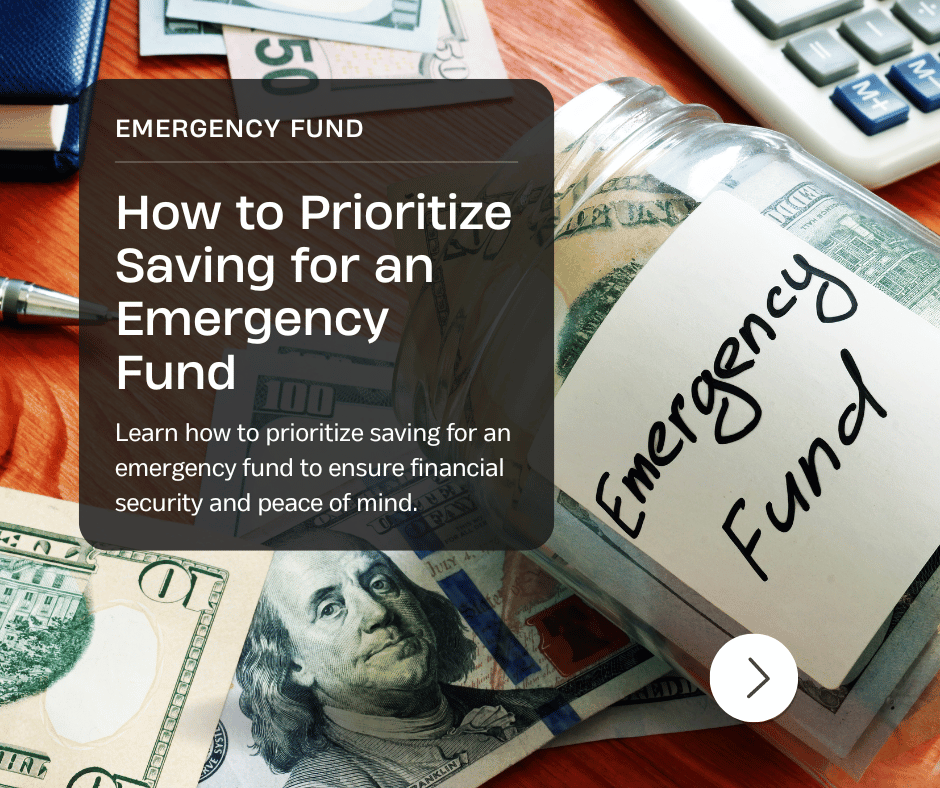Introduction to Emergency Funds
In today’s unpredictable financial landscape, having an emergency fund is more crucial than ever. An emergency fund acts as a safety net, providing a financial cushion during unexpected events like job loss, medical emergencies, or urgent home repairs. Prioritizing saving for an emergency fund ensures that you are prepared for life’s uncertainties without plunging into debt. This guide will walk you through the steps to effectively prioritize and build your emergency fund.
Importance of an Emergency Fund
The significance of an emergency fund cannot be overstated. It not only provides financial security but also peace of mind, allowing you to handle unforeseen expenses without stress. An emergency fund helps you avoid high-interest loans and credit card debt, thus maintaining your financial stability. Moreover, it gives you the flexibility to make better financial decisions, knowing you have a safety net in place.
Setting Clear Financial Goals
Before diving into saving, it’s essential to set clear financial goals. Determine what you want to achieve with your emergency fund. Is it to cover three to six months of living expenses? Or is it to ensure you can handle any unexpected large expense? Having specific goals helps you stay focused and motivated. Write down your goals and review them regularly to track your progress.
Determining the Right Amount for Your Fund
How much should you save? The rule of thumb is to save three to six months’ worth of living expenses. However, this can vary based on individual circumstances. Consider factors such as job stability, health conditions, and family size. If your job is unstable or you have dependents, you might want to aim for a more substantial fund. On the other hand, if you have a stable income and minimal expenses, a smaller fund might suffice.
Creating a Realistic Budget
A realistic budget is the cornerstone of effective saving. Start by listing all your income sources and fixed expenses such as rent, utilities, and groceries. Next, account for variable expenses like dining out and entertainment. Once you have a clear picture of your financial situation, allocate a portion of your income specifically for your emergency fund. Ensure that your budget is realistic and allows for some flexibility to accommodate unexpected expenses without derailing your savings plan.
Tracking Your Spending Habits
Understanding your spending habits is crucial in finding areas where you can cut back. Use apps or maintain a spending journal to track every expense. This practice will help you identify non-essential spending that can be reduced or eliminated. For instance, small daily expenses like coffee or snacks can add up over time and divert funds away from your savings.
Cutting Unnecessary Expenses
Once you have a clear picture of your spending habits, look for expenses you can cut. This doesn’t mean depriving yourself but making smarter choices. Cancel subscriptions you don’t use, cook at home more often, and find cheaper alternatives for necessary purchases. Redirect the money saved from these cuts directly into your emergency fund.
Automating Your Savings
Automating your savings is one of the most effective ways to ensure you consistently contribute to your emergency fund. Set up automatic transfers from your checking account to your savings account. This way, you won’t be tempted to spend the money, and saving becomes a seamless part of your financial routine.
Choosing the Right Savings Account
Not all savings accounts are created equal. Look for a high-yield savings account that offers a competitive interest rate and minimal fees. Online banks often provide better rates than traditional brick-and-mortar banks. Ensure the account is easily accessible in case of emergencies but not so accessible that you are tempted to dip into it for non-emergencies.
Using Windfalls and Extra Income Wisely
Windfalls, such as tax refunds, bonuses, or gifts, present an excellent opportunity to boost your emergency fund. Instead of spending this unexpected money, direct it straight into your savings. Similarly, if you receive a raise or start earning more, increase your savings contributions proportionally.
Establishing a Savings Timeline
Set a timeline for reaching your savings goal. Break down the total amount you need into manageable monthly or weekly targets. This approach makes the goal less daunting and provides a clear path to follow. Regularly review your progress and adjust your timeline as needed to stay on track.
Dealing with Financial Setbacks
Financial setbacks are inevitable, but they shouldn’t derail your savings plan. If you face unexpected expenses, try to minimize the impact on your emergency fund by cutting back on other areas or temporarily increasing your income through side jobs. Stay committed to rebuilding your fund once the setback is managed.
Balancing Debt Repayment and Saving
Many people struggle with the dilemma of whether to pay off debt or save for an emergency fund. Ideally, you should do both. Prioritize high-interest debt while still setting aside a small amount each month for your emergency fund. Once your high-interest debt is under control, you can increase your savings contributions.
Reevaluating and Adjusting Your Goals
Your financial situation and goals may change over time, so it’s essential to regularly reevaluate and adjust your savings plan. Life events such as marriage, having children, or changing jobs can impact your financial needs. Ensure your emergency fund goals remain relevant and aligned with your current circumstances.
Incorporating Side Hustles for Extra Savings
Side hustles can significantly boost your savings efforts. Consider freelancing, part-time jobs, or monetizing a hobby to generate additional income. Direct the earnings from these ventures into your emergency fund to accelerate your progress.
Staying Motivated and Disciplined
Saving for an emergency fund requires discipline and motivation. Celebrate small milestones along the way to keep your spirits high. Surround yourself with a supportive community, whether it’s friends, family, or online groups focused on financial goals. Visualize the peace of mind and security your emergency fund will bring to stay motivated.
Leveraging Technology for Savings
Numerous apps and tools can help streamline your savings process. Budgeting apps, savings trackers, and financial planners can provide insights and reminders to keep you on track. Utilize technology to automate savings, track spending, and receive personalized financial advice.
Involving the Entire Family in Saving
If you have a family, involve them in the savings process. Teach your children the importance of saving and make it a collective effort. Family support can provide additional motivation and ensure everyone understands the importance of maintaining the emergency fund.
Avoiding Common Pitfalls
Common pitfalls such as inconsistent saving, dipping into the fund for non-emergencies, or failing to adjust your savings plan can derail your efforts. Stay vigilant and disciplined, and regularly review your progress to avoid these mistakes.
Understanding the Role of Financial Advisors
A financial advisor can provide valuable insights and guidance tailored to your unique situation. If you’re unsure how to start or need help optimizing your savings strategy, consider consulting a professional. They can help you set realistic goals, create a comprehensive plan, and provide ongoing support.
The Psychological Benefits of an Emergency Fund
Beyond financial security, an emergency fund offers significant psychological benefits. It reduces stress, enhances mental well-being, and provides a sense of control over your financial future. Knowing you’re prepared for unexpected events can greatly improve your overall quality of life.
Case Studies of Successful Savings
Learning from others’ experiences can be incredibly motivating. Look for case studies or testimonials of individuals who have successfully built and maintained their emergency funds. Their stories can provide valuable lessons and inspire you to stay committed to your savings goals.
FAQs about Emergency Funds
What is an emergency fund? An emergency fund is a dedicated savings account set aside to cover unexpected expenses such as medical emergencies, car repairs, or job loss.
How much should I save in my emergency fund? Aim to save three to six months’ worth of living expenses. Adjust this amount based on your personal circumstances and financial situation.
Where should I keep my emergency fund? Choose a high-yield savings account that is easily accessible but not linked to your regular spending accounts to avoid temptation.
How can I save for an emergency fund while paying off debt? Balance your priorities by focusing on high-interest debt while still setting aside a small amount for your emergency fund. Increase your savings once your debt is more manageable.
What should I do if I have to use my emergency fund? If you use your emergency fund, prioritize rebuilding it as soon as possible. Adjust your budget and cut unnecessary expenses to replenish your savings.
How do I stay motivated to save for an emergency fund? Set clear goals, celebrate milestones, and involve your family in the process. Use technology and seek support from friends or financial communities to stay motivated.
Conclusion
Prioritizing saving for an emergency fund is a vital step towards achieving financial security and peace of mind. By setting clear goals, creating a realistic budget, and staying disciplined, you can build a robust emergency fund that safeguards you against life’s uncertainties. Start today and take control of your financial future with confidence.


